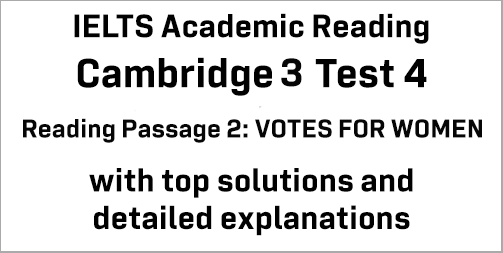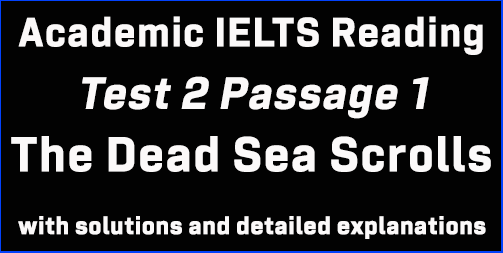IELTS Academic Reading: Cambridge 3 Test 4 Reading passage 2; VOTES FOR WOMEN; with best solutions and best explanations
This Academic IELTS Reading post focuses on solutions to IELTS Cambridge 3 Reading Test 4 Reading Passage 2 which is titled ‘VOTES FOR WOMEN’. This is a targeted post for IELTS candidates who have big problems finding out and understanding Reading Answers in the AC module. This post can guide you the best to understand every Reading answer without much trouble. Finding out IELTS Reading answers is a steady process, and this post will assist you in this respect.
IELTS Cambridge 3 Test 4: AC Reading Module
Reading Passage 2: Questions 14-27
The headline of the passage: VOTES FOR WOMEN
Questions 14-15: Multiple choice questions
[This type of question asks you to choose a suitable answer from the options using the knowledge you gained from the passage. Generally, this question is set found as the last question set in most passages so you should not worry much about it. Finding all the answers for previous questions gives you a good idea about these questions.]
Question no. 14: What is the main aspect of the suffragette movement’s work to which the exhibition at the Museum of London is devoted?
Keywords for the question: main aspect, suffragette movement’s work, exhibition, Museum of London, devoted,
We find reference to the Suffragette Movement in paragraph no. 1, “The suffragette movement, which campaigned for votes for women in the early twentieth century, is most commonly associated with the Pankhurst family and militant acts of varying degrees of violence. The Museum of
London has drawn on its archive collection to convey a fresh picture with its exhibition The Purple, White and Green: Suffragettes in London 1906-14.”
Then, in paragraph no. 2, the writer says, “The name is a reference to the colour scheme that the
Women’s Social and Political Union (WSPU) created to give the movement a uniform, nationwide image. By doing so, it became one of the first groups to project a corporate identity, . . .. ..”
Here, it became one of the first groups to project a corporate identity suggest that the main aspect was the success of the movement’s corporate image.
So, the answer is: C (the success of the movement’s corporate image)
Question no. 15: Why was the WSPU more successful than other suffrage groups?
Keywords for the question: why, WSPU, more successful, than, other suffrage groups,
The first few lines of paragraph no. 4 give us answer to this question as the writer says here, “With their slogan ‘Deeds not words’, and the introduction of the colour scheme, the WSPU soon brought the movement the cohesion and focus it had previously lacked. .. . ..”
Here, cohesion and focus = clear purpose and direction,
So, the answer is: D (It had a clear purpose and direction)
Question no. 16: Choosing TWO options from given list
[In this kind of question candidates have to choose two or three answers for each question from five or six options. The answers will not follow any sequential order as they are randomly spread in the text, so this question will be time-consuming. Skimming will come handy and previous reading of the text can come in use. Therefore, other questions should be done first before answering this question.]
In which TWO of the following years were laws passed allowing British women to vote?
Keywords for the question: TWO, years, laws, passed, allowing, British women, vote,
In lines 1-8 of the final paragraph, the author of the text writes, “Although the exhibition officially charts the years 1906 to 1914, graphic display boards outlining the bills of enfranchisement of 1918 and 1928, which gave the adult female populace of Britain the vote, show what was achieved. .. .. .”
Here, the bills of enfranchisement = laws that allows British women to vote,
So, the answers are:
D (1918)
E (1928)
Questions 17-19: Completing notes:
[In this type of question, candidates are asked to complete different notes with NO MORE THAN TWO WORDS from the passage. Keywords are important to find answers correctly. Generally, this type of question maintains a sequence. However, we should not be surprised if the sequence is not maintained. Find the keywords in the passage and you are most likely to find the answers.]
Question no. 17:
Three ways in which the WSPU raised money:
- the newspapers: mainly through selling 17. _________
Keywords for the question: three ways, WSPU, raised money, newspapers, mainly, selling,
Lines 1-8 in paragraph no. 6 mention, “Equally importantly for a rising political group, the newspaper returned a profit. This was partly because advertising space was bought in the paper by large department stores such as Selfridges, and jewellers such as Mappin & Webb.. .. . .”
Here, returned a profit = raised money,
So, the answer is: (selling) advertising (space)
Question no. 18:
- merchandising activities: selling a large variety of goods produced in their 18. _________
Keywords for the question: merchandising activities, selling, large variety of goods, produced in,
In paragraph no. 7 another way of raising money is mentioned in lines 1-10, “The creation of the colour scheme provided another money-making opportunity which the WSPU was quick to exploit. The group began to sell playing cards, board games, Christmas and greeting cards, and countless other goods, all in the purple, white and green colours. .. .. .”
Here, money-making opportunity = raised money, playing cards, board games, Christmas and greeting cards, and countless other goods = a large variety of goods,
So, the answer is: colour scheme / (three) colours / purple, white, (and) green
Question no. 19:
- additional fund-raising activities: for example, 19. _________
Keywords for the question: additional, fund-raising activities, for example,
Paragraph no. 8 has the answer to this question. The writer says here, in lines 1-10, “But the paper and merchandising activities alone did not provide sufficient funds for the WSPU to meet organisational costs, so numerous other fund-raising activities combined to fill the coffers of the ‘war chest’. The most notable of these was the Woman’s Exhibition, .. .. .”
Here, other fund-raising activities = additional fund-raising activities,
So, the answer is: (the) Woman’s Exhibition
Questions 20-26: YES, NO, NOT GIVEN
In this type of question, candidates are asked to find out whether:
The statement in the question matches with the claim of the writer in the text- YES
The statement in the question contradicts with the claim of the writer in the text- NO
The statement in the question has no clear connection with the account in the text- NOT GIVEN
[TIPS: For this type of question, you can divide each statement into three independent pieces and make your way through with the answer.]
Questions 20: In 1903 women in Australia were still not allowed to vote.
Keywords for the question: 1903, women, Australia, still not allowed, vote,
Take a look at these lines from paragraph no. 3, “Formed in 1903 by the political campaigner Mrs Emmeline Pankhurst and her daughters Christabel and Sylvia, the WSPU began an educated campaign to put women’s suffrage on the political agenda. New Zealand, Australia and parts of the United States had already enfranchised women, .. .. .”
Here, had already enfranchised women = women were already allowed to vote,
So, the answers is: NO
Questions 21: The main organs of communication for the WSPU were its two newspapers.
Keywords for the question: main organs, communication, WSPU, its two newspapers,
In paragraph no. 5 the writer says, “The newspapers produced by the WSPU, first Votes for
Women and later The Suffragette, played a vital role in this communication. Both were sold throughout the country and proved an invaluable way of informing members of meetings, marches, fund-raising events and the latest news and views on the movement.”
Here, played a vital role in this communication and an invaluable way = the main organs of communication,
So, the answers is: YES
Questions 22: The work of the WSPU was mainly confined to London and the south.
Keywords for the question: work of the WSPU, mainly, confined to, London and the south,
The final lines of paragraph no. 4 say, “ . . .. . the message had spread around the country, with members and branch officers stretching to as far away as Scotland.”
Here, as far away as Scotland = was NOT confined to London and the south,
So, the answers is: NO
Questions 23: The WSPU’s newspapers were mainly devoted to society news and gossip.
Keywords for the question: WSPU’s newspapers, mainly devoted to, society news and gossip,
Paragraph no. 5 talks about the contents of the WSPU’s newspapers, “The newspapers produced by the WSPU, first Votes for Women and later The Suffragette, played a vital role in this communication. Both were sold throughout the country and proved an invaluable way of informing members of meetings, marches, fund-raising events and the latest news and views on the movement.”
Here, the final lines of the paragraph suggest that the WSPU’s newspapers published news about meetings, marches, fund-raising events and other news on the movement.
So, the answers is: NO
Question no. 24: The Woman’s Exhibition in 1909 met with great opposition from Parliament.
Keywords for the question: Woman’s Exhibition, 1909, met with, great opposition, from Parliament,
Paragraph no. 8 talks about the Woman’s Exhibition in detail. However, whether it met opposition from Parliament is NOT MENTIONED in this passage.
So, the answer is: NOT GIVEN
Question no. 25: The Museum of London exhibition includes some of the goods sold by the movement.
Keywords for the question: The Museum of London exhibition, includes, some, goods, sold, by the movement,
The answer can be found in paragraph no. 9. The writer says in lines 6-12, “ .. .. .. copies of The Suffragette, campaign banners and photographs are all on display, together with one of Mrs Pankhurst’s shoes and a number of purple, white and green trinkets.”
So, the answer is: YES
Question no. 26: The opponents of the suffragettes made films opposing the movement.
Keywords for the question: opponents, suffragettes, made films, opposing, movement,
In paragraph no. 12 take a look at these lines, “ . . . . The programme begins with a short film devised by the ‘antis’ – those opposed to women having the vote-depicting a suffragette as a fierce harridan bullying her poor, abused husband. .. . .”
Here, the ‘antis’ = the opponents of suffragettes,
So, the answer is: YES
Question no. 27: Multiple choice questions
[This type of question asks you to choose a suitable answer from the options using the knowledge you gained from the passage. Generally, this question is set found as the last question set in most passages so you should not worry much about it. Finding all the answers for previous questions gives you a good idea about these questions.]
The writer of the article finds the exhibition to be –
Keywords for the question: writer of the article, finds, exhibition, to be,
The final lines of the final paragraph say, “ .. … . it illustrates the intelligence employed by women who were at that time deemed by several politicians to have ‘brains too small to know how to vote’.”
Here, the best match for the question is option D.
So, the answer is: D (informative)
Click here for solutions to Cambridge 3 Test 4 Reading passage 1
Click here for solutions to Cambridge 3 Test 4 Reading passage 3




sir thanks for helping me, because of you I got CLB 9 score
Hi..about Q17 … In the 6th paragraph of the passage it is stated that “….. This was partly because advertising space was bought in the paper by large department stores such as selfridges and ….” I want to emphasise on ” …partly because..” which does not mean mainly …. So isn’t something wrong ??? Thanks